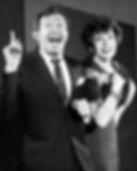96. THE BAND WAGON, 1953
- Jay Jacobson
- Mar 22, 2022
- 18 min read
One of cinema’s best and most satisfying feel-good musical comedies

One of the greatest musicals from Hollywood’s golden days, “The Band Wagon” is a Technicolor treat. With a witty wink to musicals gone by, this clever film bursts with a vibrancy and joy that is nothing short of exuberant. A nearly unequaled blend of catchy tunes, fabulous dancing, and a cheerfully enjoyable story made it one of my favorite films as a kid (it remains one of my favorite musicals), and to this day it reliably appears on Greatest Movie Musicals of All-Time lists (ranked at #17 by the The American Film Institute), and was chosen by Cahiers du cinéma as the 83rd Top film of All-Time regardless of genre. Nominated for three Academy Awards, this stunning MGM (Metro-Goldwyn-Mayer) movie musical exemplifies the flawless and complex entertainment made in a bygone era that still has the power to brighten anyone’s day.

A simple plot provides more than enough fertile ground for comedy, drama, music, and romance to flourish. It centers around washed-up movie musical star “Tony Hunter” who is traveling east to revisit Broadway. Greeted upon his arrival by his friends and colleagues, husband and wife “Lester” and “Lily Marton”, they have written a new stage musical for him titled “The Band Wagon”, and secured Broadway’s current genius, producer and director “Jeffrey Cordova” to direct, and soon enlist prima ballerina “Gabrielle Gerard” as the female star. “Gabrielle” and “Tony” start off on the wrong foot (so to speak), and it turns out “Cordova” wants to turn their lighthearted musical into a modern adaptation of “Faust”, complete with fiery furnaces of doom and a big damnation scene. All of this leads to chaos, clashing egos, romance, and lots of spectacular singing and dancing in perhaps the ultimate “backstage” movie musical. The film’s witty screenplay lovingly mocks show business, the people in it, and the movie musical itself. Though at times bittersweet, “The Band Wagon” is a full-on celebration and affirmation of the merriment created by the movie musical, and how entertainment for entertainment’s sake can be a glorious thing.


It’s no surprise this is such a solid musical, for it was made by MGM’s Freed Unit (which you can read about in my posts on "Singin' in the Rain", "Meet Me in St. Louis", and in particular, "An American in Paris"). If MGM was the capital of the movie musical (which it was), Arthur Freed was its king. A former lyricist, Freed had become a musical film producer at MGM, authorized to hire his own cast and crew. As such, he discovered and collected a roster of top-notch talent, of which "The Band Wagon" employed many, including writers Betty Comden and Adolph Green. Originally to be based on a Peter Viertel short story called "Strategy of Love”, the two writers ditched the story and came up with an original idea based on their own Broadway years, and took inspiration from a 1931 Broadway musical review titled, "The Band Wagon”, which starred Fred Astaire and featured songs by Howard Dietz and Arthur Schwartz. Comden and Green formed a story around songs from the catalogue of Dietz and Schwartz, loosely basing many of its characters on real people (including themselves in the form of “Lily” and “Lester Martin”). For their efforts, Comden and Green earned their first Best Screenplay Academy Award nomination. In a writing partnership of over sixty years (the longest lasting writing pair in Broadway history), this musical-comedy writing team performed occasionally, wrote scripts (and sometimes lyrics) for Broadway shows and Hollywood films. As a team they earned seven Tony Awards, and their Broadway shows include "On the Town", "Wonderful Town", "Peter Pan", "Bells are Ringing", "Applause", and "On the Twentieth Century”. Their films include "Singin' in the Rain", "Good News", "The Barkleys of Broadway", "Auntie Mame”, “Bells are Ringing”, and "It's Always Fair Weather" (which earned them a second and final Best Screenplay Oscar nomination). They were married, but not to each other (they were strictly writing partners). Betty Comden died in 2006 at the age of 89, and Adolph Green died in 2002 at the age of 87.

To direct “The Band Wagon”, Freed hired Vincente Minnelli. The two had previously worked together on seven films, and Minnelli had become one of Hollywood’s preeminent film directors who had a true talent for musicals. One of Minnelli’s great gifts was how he could make the theatrical seem real, and here he manages to take such clichés as “the show must go on” or clashing egos, and present them with an innovate freshness that makes them feel original. And while the film often borders on self-mocking satire, he fleshes out its world with so much thought and detail it feels credible - even when characters sing or dance.

True to Minnelli’s impeccable artistic eye and visual style, each frame of “The Band Wagon” overflows with detail, color, and sublime compositions. One need look no further than the scene when everyone is meeting for the first time at “Cordova’s” apartment while he pitches the show to backers. Minnelli pairs characters in adjacent rooms, with each room boasting its own decor and color palette which subtly reflects the emotions of its occupants. Doors open and close in a perfect mix of static shots, camera movements, and edits, creating a funny, telling, and visually arresting sequence.

If you pay attention to the film's color, you’ll be amazed by its beauty. Regarded as one of cinema's great masters of color, Minnelli picked the exact shade of every color in the film, from a glove or flower to the wallpaper and floor. He was expert at pairing colors to spark emotion and was known for his use of bright red, which is sprinkled throughout the film (and became known at MGM as "Minnelli Red"). Minnelli and Freed collaborated on several more musicals including "Brigadoon", "Kismet", "Bells Are Ringing", and the Oscar-winning "Gigi" (which earned each of them an Academy Award). You can read more about Vincente Minnelli in my post on two of his other classics, “Meet Me in St. Louis” and “An American in Paris”. Please check them out.

Minnelli, Freed, the film’s co-producer Roger Edens, and the songs' lyricist Dietz (now Vice President of Publicity at MGM), chose the film’s songs from those previously written by Dietz and Schwartz. Dietz and Schwartz collaborated on eleven Broadway shows (mostly reviews) beginning in 1929, most of which were produced in the 1930s. Songs used in this film include "By Myself", "Dancing in the Dark", "You and the Night and the Music", and "I Guess I Have to Change My Plan”. Freed, who always seemed to have an instinct for exactly what was needed, requested a “There’s No Business Like Show Business” type anthem for the film, so Dietz and Schwartz reunited and wrote the song "That's Entertainment", which became the only new song in the film. Though not a hit at the time, it has since become a show business anthem (and one that has come to represent MGM's heyday), and was voted the 45th Greatest Song in American Movies by AFI. It is sung twice in the film, including at the very end with slightly different lyrics, sung directly to the camera, reflectively driving home the film’s message that this film itself is also pure entertainment.

Like “That’s Entertainment”, “The Band Wagon” wasn’t a hit when first released. By 1953 the Hollywood Studio Era was in rapid decline and along with it, the movie musical. The studios owned their own theaters (in which they played their own films), and with the 1948 ruling that they were violating anti-trust laws and would have to give up their theaters, combined with the onslaught of television pilfering audiences, studios were no longer in a financial position to mass produce lavish, elaborate, and expensive musicals. Sadly for the genre, it had just hit its artistic peak. The year before “The Band Wagon” came “Singin’ in the Rain”, and the year before that, “An American in Paris”. Together, these three films generally constitute the apex of the movie musical genre, and are commonly considered the three greatest masterpieces made in the genre’s heyday. While 1953 saw the release of over three dozen studio produced musicals, after that, fewer musicals were made each year, and as time went on, many of the few that got made were adaptations of hit Broadway musicals (which seemed a safer financial bet, though that wasn’t always the case). “The Band Wagon” was the last stellar movie musical of its kind.


Fred Astaire stars in what many consider his best role – as has-been movie musical star “Tony Hunter”. And while “The Band Wagon” is certainly a tribute to the movie musical, it is also a sly celebration of Fred Astaire. Possibly the most important figure in movie musical history, he rose to fame in the 1930s, and with his dazzling footwork and innovative approach to filming, revolutionized the genre. One of the world’s top movie stars of the 1930s, Astaire became synonymous with elegance and class, often thought of as wearing a top hat, white tie, and tails (epitomized in his 1935 hit film "Top Hat" opposite Ginger Rogers). But by 1938 he found himself labelled “box-office poison” (along with the likes of Joan Crawford, Katharine Hepburn, Greta Garbo, and Marlene Dietrich). After World War II, the era of Astaire sophistication and carefree escapism became antiquated, and a younger celluloid king of dance took Astaire's place, Gene Kelly. Astaire's career continued with both hits and misses, and in 1946 he announced his retirement – which didn’t last long, for Freed lured him back to the screen for the classic 1948 musical “Easter Parade”. Even with his downs, by the early 1950s Astaire was a living legend and was awarded an Honorary Academy Award in 1950 for his artistry. Though he certainly wasn’t washed-up, it appeared his glory days were behind him.

When Fred Astaire became involved in “The Band Wagon”, Comden and Green decided to fashion "Tony" around Astaire at the time of his voluntary retirement. The film makes no bones about blending “Tony” and Astaire, as it opens with a shot of Astaire's moniker top hat, which we find out is "Tony's" from the height of his career, and now being auctioned off. The film again mockingly intertwines the two when we see two men chatting on a train:
“My wife used to go to see all of his ['Tony’s'] pictures”
“Well, he was good twelve or fifteen years ago, but the columnists
out there say he’s through”
Astaire is also on that train and we quickly realize he is in on the joke. As he disembarks, he begins humming the film’s first song, “By Myself”, which he continues to sing (and not dance to). While it is clearly “Tony” singing about his own career, on another level it is a touching portrait of Astaire reflecting on changing times, a theme that runs throughout the film. But never fear, true to the uplifting tone of “The Band Wagon”, any somberness quickly disappears, this time by the delightful standout musical number "Shine on Your Shoes", which "Tony" sings and dances with a shoeshine man (Leroy Daniels) in a penny arcade. In an explosion of energy and color, Astaire looks as if he is dancing on air, making it up as he goes along. His perfectly timed moves, arcade game playing, the constant flow of extras around him, and fluid camera movements – all timed to musical beats – are another illustration of the talents of Astaire, Minnelli, and the mastery of MGM at making lavishly complex musicals.

“Tony” represents the past and is often joked about as being old and outdated. Even so, Astaire was excited to play the role. He was fifty-two years old at the time, and superbly gives “Tony” a “been-through-it-all” vibe with a glint of bitter sarcasm and wounded anger. For a movie star who had only appeared in lighthearted musicals and was known for his dancing, this role offered Astaire his greatest range to date as an actor, and he is wonderful in it. His most dramatic scene also blurs “Tony” with Astaire, when he tells-off “Cordova” exclaiming, “Let’s get this straight. I am not Nijinsky. I am not Marlon Brando. I am ‘Mrs. Hunter’s’ little boy ‘Tony’, song-and-dance man. I’m supposed to have entertained millions of people in my time”. A clever way of telling us about “Tony” while also giving a nod to Astaire’s monumental legacy.


The film entertainingly shows that Astaire is changing with the times, particularly in the splendid “I Guess I’ll Have to Change My Plans” dance. In an ode to Astaire’s 1930's persona, “Tony” appears (alongside “Cordova”) in Astaire’s trademark top hat, white tie, and tails, only to drop this hat and throw down his cane at the end of the song as if he’s had enough of that. Nervous about performing a rougher, more athletic type of dance (particularly in the “Girl Hunt” ballet), Astaire requested Broadway’s Michael Kidd to choreograph the film’s dances (and Kidd became one of the giants in stage and film choreography). It worked out perfectly, as Astaire’s dancing is completely hypnotizing. “The Band Wagon” was not an easy shoot for Astaire. In addition to apprehension about a new dance style, his wife of twenty years was dying of lung cancer. Being the consummate professional, he never missed work, remained very kind to all, knew his lines, and as usual, rehearsed his dances ad nauseam until they were ingrained into his (and his partner's) body. He is quoted in Stephen Harvey's biography, "Fred Astaire" as having "endlessly proclaimed his refusal to find himself one day pirouetting across the screen arrayed with top hat, white hair, and crutches". That never happened, for Astaire starred in just three more musicals (“Daddy Long Legs”, “Funny Face”, and “Silk Stockings”) before song-and-dance-man musicals vanished from the screen. He then turned to drama (and earned his only Academy Award acting nomination for Supporting Actor in 1974's "The Towering Inferno"). Astaire appeared in just one more musical, "Finian's Rainbow" in 1968, and in the three "That's Entertainment" MGM musical compilation films. You can read more about the immortal Fred Astaire in my post of “Top Hat”. Click the film’s title to read more.


Cyd Charisse stars as prima ballerina “Gabrielle Gerard”. "The Band Wagon" was her first major acting role and Minnelli sought her for the part because of her elegance and incredible dancing. He worked with her on her acting, and whatever she might lack in that department in this film, she more than makes up for with her electrifying and wide-ranging dance moves. Arguably the greatest female dancer in the movies, in addition to her skill and beauty, Charisse was known for her knockout legs that seem to go on for miles. With an immensely likable screen magic, she keeps the viewer’s eyes glued to her whenever on-screen. We first see her when “Tony” first sees her, dancing in a ballet. The number highlights Charisse’s refined ballet skills along with her gorgeous gams. “Tony’s” reaction is that she’s both beautiful and talented but he can’t dance with her because she's too tall and he thinks he'd look silly dancing with a ballerina. Both were reportedly true concerns for Astaire before working with Charisse (she came from the world of ballet), and Comden and Green again put reality into the script, making Astaire’s concerns about Charisse, “Tony's” concerns about "Gabrielle". In the end neither posed a problem (without shoes Charisse was actually about two inches shorter than Astaire), and Astaire later fondly wrote of Charisse in his autobiography “Steps in Time”: ”When you've danced with her you stay danced with". Though she is seen singing two songs, Charisse's singing voice was dubbed by singer India Adams.

Charisse and Astaire had fantastic dance chemistry, best seen in a polished revisit to the dances of Astaire and Rogers in the song “Dancing in the Dark”. When “Gabrielle” comes to “Tony’s” hotel and asks, “Tony, can you and I really dance together?”, they head to Central Park via horse and carriage to find out. Both dressed in white (she in a sensuously flowing skirt), they walk past other people dancing, and quietly begin a pas de deux surrounded by green, the city skyline, and the night sky. They ever so gracefully dance together in what is undoubtedly one of the most romantic scenes in cinema history (and one of movie musicals' most iconic). As they realize they can indeed dance together, without a word they fall in love. Romance like this no longer exists in movies. Captured by Minnelli's delicate hands, they softly and silently slip back into the carriage as two changed people. Sheer perfection. An homage to “Dancing in the Dark” was famously paid in a 1978 episode of “Saturday Night Live”, humorously danced by Gilda Radner and Steve Martin.

Charisse’s dancing is quite magnificent, and she stands out in another of the film’s major dance numbers – the nearly twelve minute “Girl Hunt” ballet, a tongue-in-cheek spoof of Mickey Spillane type detective novels. In it, Charisse plays two characters – a blonde damsel in distress and a black haired, long legged vamp. It's a fabulous showcase of her talents, dancing in a romantic and tender fashion as the blonde, and by contrast as the seductively aloof gal with the undulating hips and robust legs who the Astaire character describes as having “more curves than a scenic railway”. Charisse puts her soul into her moves using all of her body (shoulders, finger, arms, and legs) without inhibition, and it is simply electrifying. Kidd’s choreography, which uses dance moves in fights and for seduction (do I see a precursor to the dance style of Jerome Robbins’ “West Side Story”?), accentuates Charisse’s endless legs and smoldering allure, and the ballet is certainly one of the film's highlights. Actress Julie Newmar appears for a second or two in the ballet as a red-haired beauty modeling dresses in a purple dress shop. The "Girl Hunt" ballet was used as a reference for Michael Jackson’s 1988 "Smooth Criminal" music video.


To build strength after a bout of polio, Texas born Cyd Charisse began dancing at the age of six, and by the age of twelve was dancing for the Ballet Russe de Monte-Carlo. By the time she was twenty, Charisse began appearing in small roles in films beginning with 1941's "Escort Girl" as a flamenco dancer. In 1943, she joined the Freed Unit as a ballet dancer, and after being put through MGM's grooming process, began appearing in small roles (often dancing ballet) in "Thousands Cheer”, "Till the Clouds Roll By”, and 1944's "Ziegfeld Follies" (where she briefly danced with Astaire). She was soon getting supporting roles in musicals like "The Harvey Girls" and "On an Island with You", and the dramas "Tension" and "East Side, West Side". In 1952, Charisse danced opposite Gene Kelly in two songs in the classic musical "Singin' in the Rain” (in a ballet wearing a twenty-five foot floating scarf, and as a dancing vamp in the film's "Broadway Melody Ballet" finale). Her emotive and powerful dancing didn't go unnoticed, and that film became her breakthrough. Two films later came "The Band Wagon", and with her newly found status, she starred in such musicals as "Brigadoon", "It's Always Fair Weather", "Meet Me in Las Vegas", and again opposite Astaire in "Silk Stockings" in 1957, which proved to be her last musical. With the genre’s decline, Charisse turned to drama, including "Twilight for the Gods", "Party Girl", and "Two Weeks in Another Town" directed by Minnelli. Come the 1970s, Charisse worked predominantly on television, appearing on such shows as "The Love Boat", "Fantasy Island", "Murder She Wrote", and her final performance in the 2008 TV movie, "Empire State Building Murders". She appeared in many specials and documentaries about the Golden Age of Hollywood, including her final film appearance in 1994's MGM musical tribute to classic musicals, "That's Entertainment III". She made her only Broadway appearance in the musical "Grand Hotel” as the ballerina "Elizaveta Grushinskaya” in 1991. In 2006, she was given the National Medal of the Arts and Humanities (the highest official US honor for the arts). She was married twice, including her second marriage of sixty years to singer Tony Martin, which ended with her death. Cyd Charisse died in 2008 at the age of 87. Being my favorite female dancer, I was overjoyed to meet Cyd Charisse twice. A very classy lady on and off-screen. I briefly wrote about her in my post on “Singin’ in the Rain”.


Oscar Levant plays “Lester Marton”, husband of “Lily” and friend to “Tony”. A real-life renowned concert pianist, Levant gets a very brief chance to play piano during the “I Love Louisa" musical number. A personal friend of Minnelli and the screenwriters, they infused the character of “Lester” with many of Levant's traits, including his wisecracking sardonic wit and well-known hypochondria. According to co-star Nanette Fabray, Levant made things difficult on the set, especially for her until she yelled back at him one day, after which he stopped. Levant had recently suffered a series of heart attacks and had trepidation about dancing in the film and as a result, he doesn't dance much. A Broadway conductor and composer and major figure on American radio, Levant appeared in just over a dozen films, and “The Band Wagon” was his next to last (his final was "The Cobweb" in 1955, also directed by Minnelli). A tortured soul addicted to painkillers, Levant went in and out of mental institutions late in his life and died of a fatal heart attack in 1972. Oscar Levant also appeared in "An American in Paris", and you can read a bit more about him in my post on that classic.

Nanette Fabray plays “Lily Marton”, wife of “Lester” and friend to “Tony”. Filled with an energetic zest, Fabray provides a great counterpart to the gruff “Lester”, and instills an earnest enthusiasm into the “let’s put on a show” motif. She sings several songs in the film, most famously “Triplets” alongside Astaire and Buchanan. Another of the film’s standout musical numbers, this film made that 1930’s song immortal. Originally, Levant was to be in the number but refused to do it, so Fabray took his place, and thank goodness. A movie musical marvel, this delightful song is perfectly suited to Fabray's charismatic charm, and her facial expressions alone are priceless. Dressed in baby clothes and in highchairs, the three sing of the woes of being triplets. Their adult sized heads and tiny legs are a visual wonder, and I’ll talk about how they did it in the TO READ AFTER VIEWING section below, for after you watch the film. Fabray also cheerfully sings the effervescent "Louisiana Hayride”, takes part in both renditions of “That’s Entertainment”, and adroitly handles both the film’s drama and comedy. “The Band Wagon” remains her best remembered role.


Raised by a stage mother, California born Nanette Fabray began tap dancing as a very young girl (studying with Bill "Bojangles" Robinson) and made her professional stage debut at the age of three. She began dancing and singing in vaudeville, and appeared in her first film, "The Private Lives of Elizabeth and Essex" in 1939 at the age of nineteen. She made a couple more film appearances while continuing in theater, making her Broadway debut in 1940 with "Meet the People". Fabray worked steadily on Broadway throughout the 1940s, earning a Tony Award for the musical "Love Life" in 1949. In the early 1950s she began appearing on TV, soon as a regular on the landmark "Caesar's Hour" from 1954 until 1956, which earned her three Emmy Awards. With a career spent extensively on television, Fabray appeared in only about a dozen films, including "The Happy Ending", "Harper Valley PTA", and her final film, the 2003 documentary "Broadway: The Golden Age, by the Legends Who Were There". She had recurring roles on such TV shows as "The Mary Tyler Moore Show", "One Day at a Time", and “Coach”, and earned a second Tony Award nomination for the 1953 musical, "Mr. President". When she was twenty years old, Fabray was diagnosed with conductive hearing loss and became a longtime activist for hearing awareness and a supporter of the deaf, and she often used American Sign Language in her TV appearances (including "The Carol Burnett Show", and "Match Game '73"). She was awarded both the President's Distinguished Service Award and the Eleanor Roosevelt Humanitarian Award for her efforts. Married twice, after the death of her second husband she began working to change the laws towards inheritance taxes and asset protection for widows and widowers. Nanette Fabray died in 2018 at the age of 97.


Jack Buchanan plays eccentric director and performer “Jeffrey Cordova”. He does a fine job bringing an offbeat zaniness and debonair flair, such as when performing in "Oedipus Rex", or singing and dancing alongside Astaire. The shoot was also a rough one for him, as he suffered three root canals during production. Scottish born Jack Buchanan was a very famous musical comedy star in the UK who personified an upperclass man-about-town. His career began on stage and his big break came in the 1921 review "A to Z", which included the musical number "And Her Mother Came Too" (which became his signature song). His stage career flourished through the 1930s on the British and New York stages. Buchanan began appearing in British films in 1917 with "Auld Lang Syne", and his first American film was 1929’s “Paris”. He became one of the top ten British box-office stars of the late 1930s, and in his career appeared in a total of about thirty films, including the British films "The Gang's All Here", "As Long as They're Happy", "Brewster's Millions", and "The Sky's the Limit" (which he also directed), and the Hollywood films "The Show of Shows" and "Monte Carlo". In addition to acting, singing, dancing, producing, and directing both on stage and in films, Buchanan also worked on radio, including "The Jack Buchanan Show" and "Man About Town". He was married twice. "The Band Wagon" remains his most remembered role for international audiences. Jack Buchanan died in 1957 at the age of 66.

In addition to Comden and Green’s Best Screenplay Academy Award nomination, "The Band Wagon” earned Oscar nominations for Best Costume Design (Mary Ann Nyberg) and Best Musical Score (Adolph Deutsch). In addition, my steady blog readers should recognize the names of one of the film's two art directors, Cedric Gibbons, and that of Douglas Shearer, the film’s recording supervisor. "The Band Wagon" references many famous people, and actress/movie star Ava Gardner appears in a quick cameo as herself.

One of cinema’s best musicals, this week’s film offers a Technicolor delight for the eyes, musical gems for the ears, and joyous fun for the heart. A film that can perk up even the most gloomy of moods, enjoy the fabulous “The Band Wagon”!
This blog is a weekly series (currently biweekly) on all types of classic films from the silent era through the 1970s. It is designed to entertain and inform movie novices and lovers through watching one recommended classic film a week. The intent is that a love and deepened knowledge of cinema will evolve, along with a familiarity of important stars, directors, writers, the studio system, and a deeper understanding of cinema. I highly recommend visiting (or revisiting) the HOME page, which explains it all and provides a place where you can subscribe and get email notifications for every new post. Visit THE MOVIES page to see a list of all films currently on this site. Please leave comments, share this blog with family, friends, and on social media, and subscribe so you don’t miss a post. Thanks so much for reading!
YOU CAN STREAM OR BUY THE FILM HERE:
OTHER PLACES YOU CAN BUY THE FILM:
TO READ AFTER VIEWING (contains spoilers):

The unforgettable and visually arresting “Triplets” musical number was accomplished by strapping the actors’ heels to their thighs and hiding their legs in black. A plaster cast was made of their legs from which a leather case was formed and placed over their thighs. Inside was a steel rod to which the baby shoes were secured at the bottom. The actors learned to dance on their knees, and the trickiest part was when they jumped out of their highchairs, as one of them would inevitably fall, and they’d repeatedly have to start all over and over again. According to Fabray, the process was quite painful. But boy, did they create magic!




